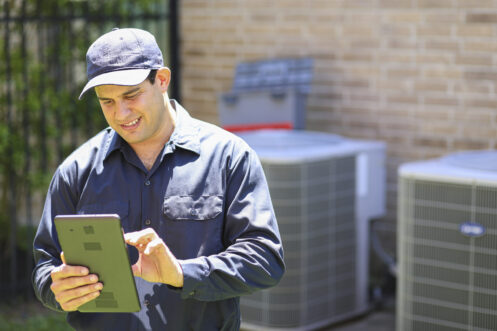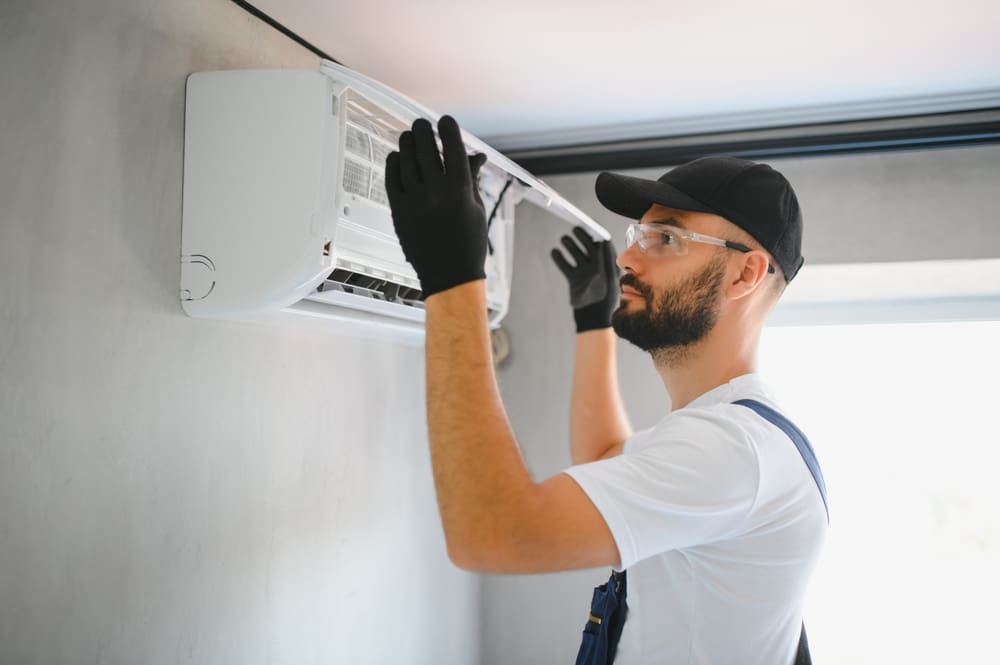
Summer is your air conditioner’s time to shine. With temperatures in Las Vegas, NV holding steady in the triple digits, the months of June through September wouldn’t be survivable without it. Getting your AC ready for this high-demand season will optimize its efficiency, lower your energy bills, and protect your indoor air quality (IAQ). Pre-season preparation can also prevent costly repairs and dangerous home cooling emergencies. The following are eight ways to get started.
1. Check and Clean the Area Around Your Air Conditioner’s Outdoor Condenser
Installed in either your back or side yard, your air conditioner’s condenser needs at least 24 inches of clearance on all sides. In spring, fast-growing grasses, shrubs, weeds, and trees can encroach upon this unit and block airflow. Airflow obstructions at your condenser unit can lead to poor airflow from your air vents, the distribution of warm air, overheating, short cycling, and circuit breaker trips.
Remove all leaves, twigs, and other loose, organic debris. You should also cut back all branches, brush, and other foliage. Be sure to check your AC condenser throughout the season to keep its perimeter clear.
2. Inspect and Replace Your HVAC Air Filter
Start the cooling season off with a fresh and properly fitted HVAC air filter. Try to establish an easy-to-remember filter change schedule so that this important component is never overlooked. In general, homeowners should inspect their air filters every 30 days and replace them every one to three months.
Stock up on Replacement Filters
You’ll need between two and six air filters for the summer season. In hot, arid climates like Las Vegas, the average lifespan of air filters is much shorter than the national average. To sidestep the hassle of finding empty store shelves when your filter needs replacing, stock up before demand increases. Loading up on these components early often means having access to lower prices.
3. Inspect and Clean Your HVAC Air Vents
When your filter becomes too heavy with debris, small clumps can break off and make their way through your HVAC system. Dirt, dust, lint, hair, and other particulates eventually land at the backs of HVAC air vents. Fortunately, you can easily wipe these features clean with a soft, damp cloth. If necessary, you can also remove your vent covers and vacuum behind them with your vacuum cleaner’s hose attachments.
Check Your HVAC Air Vent Positions
Not every vent in your home needs to be fully opened, but none of them should be closed completely. If residents frequently shut the air vents in their immediate areas, your heater and air conditioner could be working harder than necessary. Closing HVAC air vents causes a significant rise in in-duct static pressure. If left unchecked, this pressure will accelerate normal HVAC wear and cause performance issues.
If you find any vents that are completely closed, open them up. If you’re looking for a high-return home improvement, having your HVAC system zoned for customized climate control is an excellent choice. Zoning allows residents to control the temperatures in their immediate areas without adding additional air pressure to HVAC ducting.
Schedule Air Balancing Service
During air balancing, we adjust air vent and duct damper positions to ensure optimum airflow. Standard, central HVAC systems should heat and cool homes uniformly. If you have hot and cold spots throughout the building when your AC is running, air balancing might be the right solution.

4. Check and Maintain Your Roof
Neglecting roof maintenance could have a devastating effect on your air conditioner if any of your roof’s asphalt shingles, tiles, flashing, or other elements fall off. Even simply removing debris from your gutters and downspouts will:
- Route runoff away from your AC condenser
- Prevent heavy gutters from detaching from the building
- Deter pests from congregating in the area
- Support the overall health and integrity of your roof
Scheduling annual roof inspection services and timely roof repairs will limit your condenser’s risk of sustaining serious, impact-related damage.
5. Limb Your Trees
Limbing your trees is just as important as tending to your home’s roof, especially if you have trees that tower above your AC condenser. Tree care experts remove weak, dead, and diseased limbs and branches. They also thin out heavy canopies to make trees less top-heavy. With March through June being the windiest months in the region, it’s best to schedule tree care in mid-spring or earlier.
6. Schedule an HVAC Air Duct Inspection
Don’t mistake the quick ductwork inspections that HVAC technicians perform during AC and heater tune-up services as replacements for comprehensive duct maintenance. Your HVAC air ducts need their own tune-up service each year. We thoroughly test both exposed and concealed ducting throughout the building. We check for leaks and loose connections. We can also seal and insulate your air ducts if you haven’t done so already.
Consider Air Duct Cleaning
When it comes to optimizing AC efficiency and airflow, keeping your air ducts clean is just as important as changing your air filter and wiping down air registers, vents, or grilles. According to the National Air Duct Cleaners Association (NADCA), consumers should schedule duct cleaning services every two to three years. If you haven’t done so in a while, having your ducts cleaned now could improve your air conditioner’s summertime performance and lower your cooling costs.
7. Schedule AC Tune-up Service
Scheduling AC tune-up service before summer arrives is a must. Annual air conditioner service is a standard requirement in AC manufacturer warranties. It’s also the best way to extend the lifespan of your cooling equipment, stave off cooling emergencies, and limit your carbon footprint.
During tune-up service, we look for minor and developing issues. Catching and resolving problems early on limits their magnitude, effects, and overall cost. We also lubricate moving parts, replace worn components, calibrate thermostats, and clean AC evaporator and condenser coils among many other things. Our tune-up services prevent common problems like refrigerant leaks, overheating, and poor humidity control.
8. Don’t Forget Your Integrated HVAC Accessories
If you have a whole-house humidifier, air scrubber, or air purifier installed, spring is a good time to have it inspected and maintained. Integrated accessories like these are installed in HVAC ducting or attached to it. They treat conditioned air just before it’s distributed. When they aren’t well-maintained or working properly, air conditioner performance can suffer for it.
If you don’t currently have an integrated HVAC accessory, find out whether you need one by scheduling a professional IAQ assessment. With autumn allergy season often making an early August arrival, getting additional IAQ support could be essential. IAQ assessments identify and list airborne contaminants and their concentrations. They also measure indoor humidity.
We’re proud to serve Las Vegas, NV and the surrounding communities. We offer exceptional heating, cooling, plumbing, and indoor air quality services. Our clients can also count on us for top-quality heat pumps and HVAC air duct sealing. To schedule an appointment, contact BEST Air Conditioning Plumbing Repair now!

